How to Write a Case Study: Guide With Free Template + Examples
Case studies are a powerful way to illustrate the effectiveness of a strategy, service, or product in real-world scenarios. They offer valuable insights into the challenges faced by individuals or organizations and how those challenges were successfully tackled. Whether you’re a student, a marketing professional, or a business owner, knowing how to write a compelling case study can help you convey information in a persuasive and engaging way. This article will guide you through the process of creating a case study, provide you with free templates, and offer examples to inspire your writing.

Understanding the Purpose of a Case Study
Before diving into the mechanics of case study writing, it’s crucial to understand its purpose. A case study serves several key functions:
Validation of Skills or Products : For businesses, case studies are critical for demonstrating the effectiveness of their services or products. They provide real-world examples that potential clients can relate to.
Problem Resolution : They illustrate how specific challenges were addressed and highlight successful strategies.
Teaching Tool : For educators and students, case studies present opportunities to apply theoretical knowledge to practical scenarios.
Engagement : A well-written case study can capture the interest of readers and encourage them to learn more about the subject matter, leading to potential leads or further research.
Influencing Decisions : In a business context, case studies can sway potential clients by showcasing past success stories, helping to overcome objections or hesitation.
Components of a Case Study
A well-structured case study contains several components that work together to tell a cohesive story. Let’s break down them:
Title : The title should be catchy and informative, giving a clear idea of what the case study is about.
Executive Summary : This is a brief overview that summarizes the case study’s content, objectives, and results. While this section appears first, it’s often easiest to write it last.
Introduction : It introduces the topic, provides context, highlights the significance of the case study, and outlines the objective.
Background Information : Here, you detail the subject of the case study, including relevant historical data, the organization or individual involved, and any pertinent details contributing to the case.
Challenges or Problems : This part should outline the issues or challenges faced by the subject. Include quantitative and qualitative data to emphasize the severity and impact of these problems.
Solution or Intervention : Describe how the problems were addressed. Detail the strategies, methods, or services employed to resolve the challenges.
Results and Outcomes : This section should discuss the results of the actions taken. Use data, quotes, and other evidence to present a clear picture of the effectiveness of the solutions provided.
Conclusion : Sum up the case study, emphasizing what was learned and how it applies to broader contexts.
Call to Action : End the case study with a call to action, encouraging readers to reach out for more information or to engage with the brand or subject discussed.
References : Any sources of information used in the case study should be cited to lend credibility.
Steps for Writing a Case Study
Step 1: select the case.
Choosing the right case to study is crucial. You want to select a subject that is relevant, interesting, and provides an opportunity to showcase understanding, problem-solving, or the effectiveness of a strategy.
Step 2: Conduct Research
Conduct thorough research to gather all necessary information regarding your chosen case. This could include:
- Interviews : Speak with key stakeholders involved in the case, such as clients, customers, or team members.
- Existing Documentation : Review any existing reports, presentations, or other documentation related to the case.
- Quantitative Data : Gather relevant statistics, metrics, or other data that can be useful in illustrating the situation.
Step 3: Create an Outline
Draft an outline that incorporates the main components of your case study. This will give you a roadmap to follow during the writing process and ensure that you cover essential points.
Step 4: Write the First Draft
With your outline in hand, start writing your first draft. Focus on getting your ideas down without editing yourself too much at this point. You’ll refine them in subsequent drafts.
- Be Clear and Concise : Use clear language and avoid jargon unless it’s necessary for your audience.
- Tell a Story : Frame the case study as a narrative to make it more engaging and relatable.
Step 5: Revise and Edit
Once you have your first draft, take time to revise it. Look for clarity, coherence, and conciseness. Ensure that each section logically flows to the next, and eliminate any unnecessary information.
- Check for Errors : Proofread the document to catch any grammatical or typographical errors.
- Seek Feedback : If possible, ask for feedback from peers or mentors who can provide an external perspective.
Step 6: Format the Case Study
Format your case study for readability. Use headings, subheadings, bullet points, and visuals (graphs, charts, or images) to make the document more engaging and easier to follow.
Step 7: Publish and Distribute
Once formatted, it’s time to publish your case study. Depending on your goals, you may:
- Share it on your website or blog.
- Use it for PR or marketing.
- Present it in a professional setting or workshop.
Make it accessible to your target audience, whether that’s through social media, newsletters, or direct outreach.
Free Template for Writing a Case Study
Case study template.
Title : [Insert catchy and informative title]
Executive Summary :
- Briefly summarize the case study’s objectives, challenges, and results.
Introduction :
- Introduce the topic and explain its relevance.
Background Information :
- Provide context about the organization or individual involved, including relevant history.
Challenges or Problems :
- Clearly outline the challenges faced, supported by data and examples.
Solution or Intervention :
- Describe the strategies or methods applied to address the challenges.
Results and Outcomes :
- Discuss the effectiveness of the solution with data, quotes, and observations.
Conclusion :
- Summarize the main points and discuss the broader implications.
Call to Action :
- Encourage readers to take the next step, whether that’s contacting you for more information or visiting your website.
References :
- List any sources cited in the case study, formatted appropriately.
Examples of Successful Case Studies
Example 1: ecommerce business growth.
Title : "How XYZ eCommerce Increased Sales by 120% in Just 6 Months"
Executive Summary : In this case study, we explore how XYZ eCommerce, a mid-sized online retailer, faced declining sales in 2022. By implementing targeted marketing strategies and a website overhaul, they achieved a remarkable 120% increase in sales over six months.
Introduction : As the eCommerce landscape becomes increasingly competitive, retailers must adapt swiftly or risk losing market share. XYZ eCommerce was no exception as they struggled against better-positioned competitors.
Background Information : Founded in 2015, XYZ eCommerce initially thrived with their unique product offerings. However, by 2021, sales began to plateau due to a lack of online visibility.
Challenges or Problems : XYZ faced several key challenges:
- Outdated website design that affected user experience.
- Poor search engine ranking, limiting organic traffic.
- Inadequate engagement with potential customers via social media.
Solution or Intervention : The following strategies were employed:
- A complete redesign of the website focused on user experience and conversion optimization.
- Implementation of a targeted SEO strategy to improve organic search visibility.
- Launch of a social media marketing campaign aimed at engaging potential customers.
- The website redesign led to a 50% increase in average session duration and a 35% decrease in bounce rate.
- SEO efforts boosted organic traffic by 80%, leading to higher conversions.
- Social media campaigns increased engagement rates by 150%, contributing to a 120% growth in overall sales.
Conclusion : XYZ eCommerce’s case illustrates the power of a comprehensive digital strategy in revitalizing an online business. Adapting to market demands and investing in marketing are vital for sustainability.
Call to Action : Looking to increase your sales? Contact us to learn how our tailored solutions can help your business thrive online.
- Internal sales data
- Google Analytics reports
- Customer feedback surveys
Example 2: Non-Profit Organization Fundraising Strategy
Title : "How ABC Non-Profit Raised $500,000 in Donations in One Year"
Executive Summary : This case study explores ABC Non-Profit’s innovative approach to fundraising in 2022, which resulted in raising $500,000 to support community programs.
Introduction : Non-profits often face the perennial challenge of securing funding. ABC Non-Profit sought to break new ground in fundraising strategies during a particularly tough year.
Background Information : ABC Non-Profit, founded in 2005, provided crucial community services. However, decline in traditional fundraising methods prompted a need for innovation.
- Reduced funding from traditional sources due to budget cuts.
- Declining attendance at annual fundraising events.
- Launched a digital fundraising campaign using social media and email outreach.
- Organized virtual fundraising events to engage a broader audience.
- Created partnerships with local businesses to match donations.
- The digital campaign generated significant traction, leading to 300% growth in online donations.
- Virtual events attracted double the audience compared to in-person events.
- Partnerships resulted in additional matched funding enhancing overall donations.
Conclusion : ABC Non-Profit’s proactive approach in 2022 illustrates the potential of digital fundraising strategies and community engagement in overcoming financial challenges.
Call to Action : Are you ready to transform your fundraising efforts? Get in touch for tailored strategies designed to meet your organization’s unique needs.
- Internal financial reports
- Participant feedback from events
- Social media engagement analytics
Writing a case study effectively requires careful planning, thorough research, and compelling narrative skills. By following the steps outlined in this guide, utilizing the template provided, and referencing the examples, you can create impactful case studies that not only showcase expertise but drive interest and engagement. Whether applied in academia, business, or non-profit sectors, mastering the art of case study writing will enhance your communication skills and promote a deeper understanding of complex subjects.
As you embark on your case study writing journey, remember that the goal is to tell a story that connects with your audience, illustrating how real-world challenges have been overcome through specific actions. Happy writing!
Leave a Comment Cancel reply
Save my name, email, and website in this browser for the next time I comment.
- Content Writing Services
- Get in Touch
10 Components of a Case Study You Absolutely Need to Include
Updated July 2024: SaaS case studies are essential for demonstrating the value of your products and showcasing the success your customers have experienced. To streamline the creation of these case studies, adhering to a specific case study format is vital. In this post, discover the 10 key components of a case study that you need to include.
This post is part of a series on how to write a B2B case study .
Components of a case study : must-have elements for success
1. develop a results-oriented title.
Your case study title needs to resonate. Do this by providing results-oriented information your audience cares about. Your title should include the name of the customer, the product or solution they used, and the main benefit or result.
Company A Uses Company B to Level Up Its Customer Experience and Drive 105% Increase in Revenue
2. Craft an engaging executive summary
One of the most crucial components of a case study is a compelling executive summary . It tells your potential customer what to expect and how they might be able to relate to the information provided.
Begin by introducing your customer and their challenges. Then, emphasize how your B2B SaaS company helped deliver the right solution. Finally, include a preview of the outcomes your customer achieved with your products.

3. Outline your customer’s challenges
By asking the right case study questions , you can illustrate the obstacles your customer faced that prompted them to seek out a B2B SaaS solution. For example, maybe previous solution was a drain on time, resources or budgets.
This section is an ideal spot to use a customer quote and let them share their story in their words. Remember to paint your customer in a positive light. Focus on how they wanted to improve their business and avoid overly negative language.
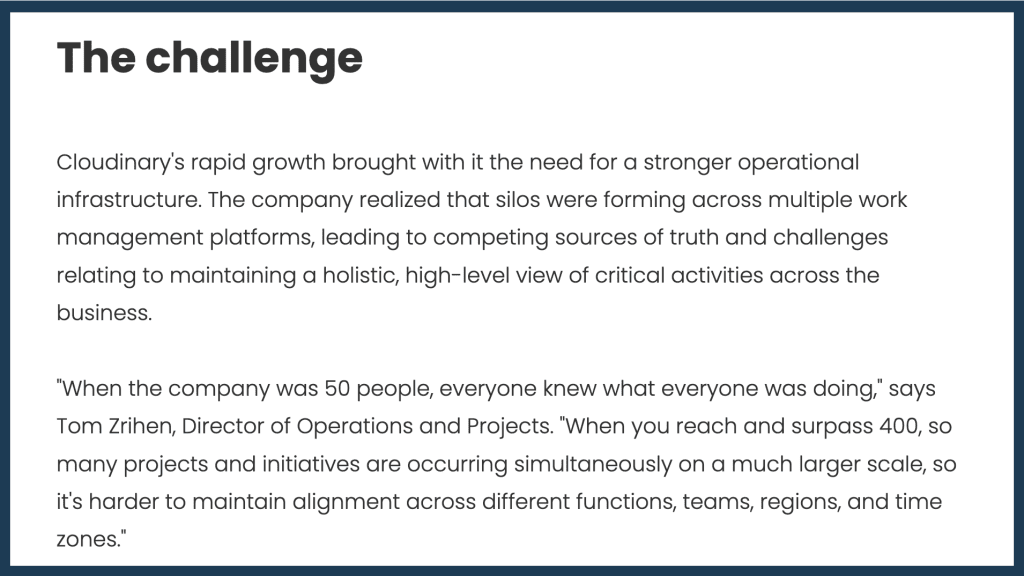
Source: monday.com
4. Lead your reader along your customer’s journey
Help your reader picture themselves in your customer’s shoes. Lay out the steps your customer took to try to solve their problem, including an overview of the other products they investigated before they decided on yours. But be mindful not to toot your own horn—you’re simply recapping the facts.

Source: Envysion
5. Share the moment of discovery
The core components of a case study wouldn’t be complete without a section on how your customer decided on your specific B2B SaaS solution.
First, provide insight into which of their business requirements it met. Then include any other reasons the partnership was a good fit—perhaps your companies shared similar organizational values.
This is an area where case study testimonials make for powerful storytelling. They allow you to set your case study up to dive into how you and your product solved your customer’s challenges.
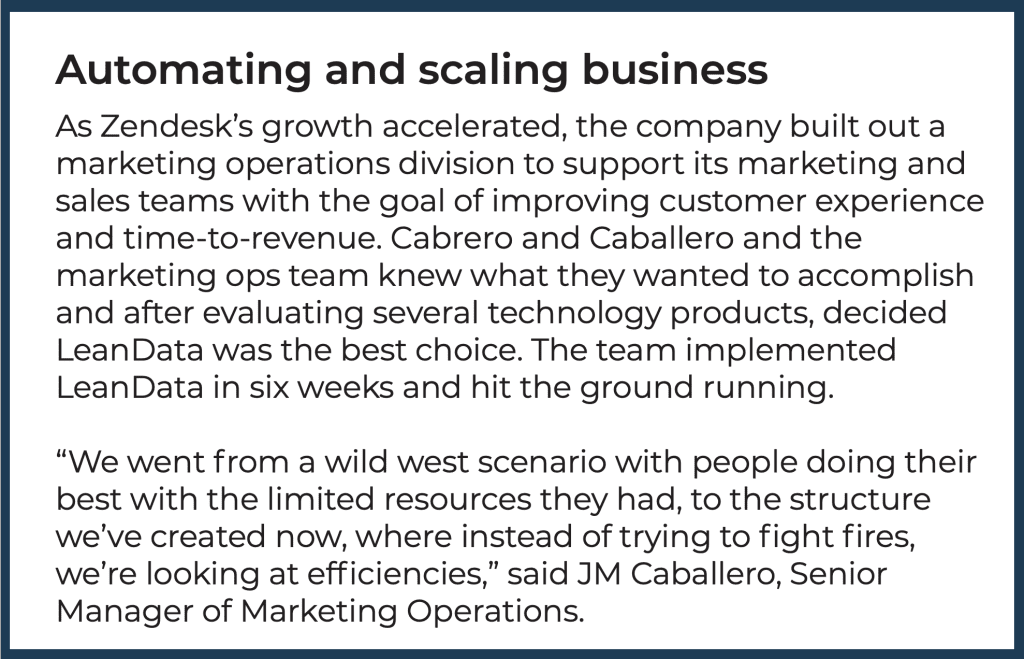
Source: LeanData
6. Spend some time on the solution
In the “solution” component of your case study, you get to pitch your products without the fear of sounding like a used car salesman. Remember, you didn’t rush in and save the day—this is about your customer’s goals and how your solution helped them reach their objectives. As a result, you simply need to outline the products your customer purchased and the benefits they provided.
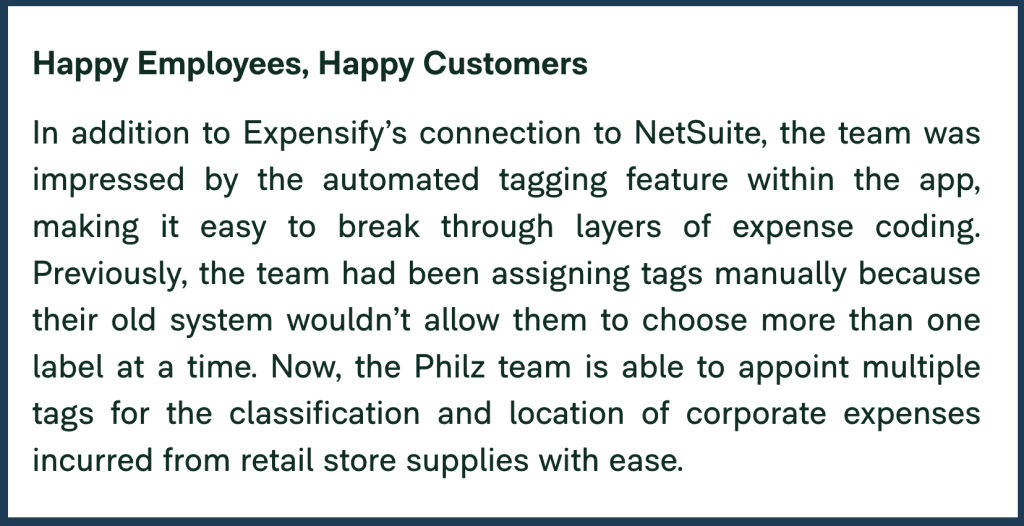
7. Walk your reader through the implementation
Change can be daunting, especially when it comes to the unknown, so it’s crucial that you give your reader a clear sense of how the implementation process went for your customer.
For example, if problems arose, don’t be afraid to be transparent about them, but tie the storyline back to how you and your customer overcame the challenges. This is one of the most important components of a case study, and is an opportunity to let your customer service shine.
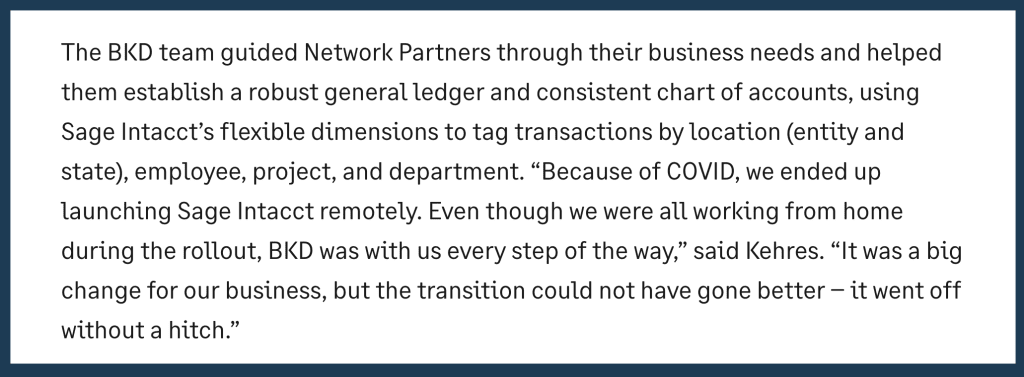
Source: Sage
8. Celebrate your customer’s results
77% of SaaS companies include metrics in at least 50% of their case studies . Metrics are where you can show off the data—hard numbers like revenue gains and time saved that illustrate the return on investment your customer gained from your solution.
Showcase how well your products solved the customer’s problems. Find out what to do if you don’t have case study metrics to work with.
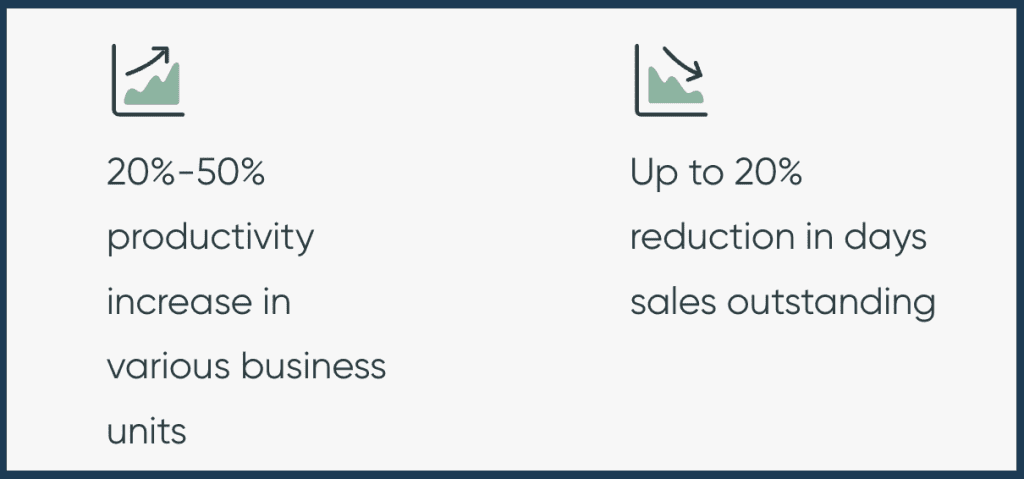
9. Close the loop with a call to action
Using the right components of a case study so far has helped keep your reader’s attention until the end of the piece, creating an important opportunity for you to guide them to the next step you want them to take. You can accomplish this by including a clear call to action (CTA) that speaks directly to them at the end of your B2B SaaS case study. See these case study CTA examples to learn how to make your calls to action stand out.

10. Don’t get too caught up in using the perfect format
A lot of experts will tell you that your content needs to include all of the components of a case study and follow a structured formula. But don’t stress over this.
A creative story doesn’t lock itself into anything too prescriptive. And you don’t have to chunk your content into specific modules like some ’90s business plan. The most interesting and compelling stories take a creative approach to case study format , and they play with perspective.
10 components of a case study: did you include them all?
Now that you know the 10 parts of a case study, take a look back through your own case studies. Have you included each of the components?
Moving forward, a good way to ensure you capture the whole story accurately is to fill out a case study brief before you start. This will help ensure you get a timely case study approval from your customer.
And last, but certainly not least, have you squeezed every last ounce of value from your case studies? Here are 13 ways to repurpose your case studies for maximum results.
Get help writing your case studies
Partnering with a SaaS content marketing agency like Uplift Content allows you to produce a consistent flow of high-quality marketing and sales collateral that generates and nurtures leads—and closes sales faster. Check out our case study writing services .

As the founder of Uplift Content, Emily leads her team in creating done-for-you case studies, ebooks and blog posts for high-growth SaaS companies like ClickUp, Calendly and WalkMe. Connect with Emily on Linkedin
Sign up for the Content Huddle newsletter
Learn from Emily’s 17 years of aha moments, mistakes, observations, and insights—and find out how you can apply these lessons to your own marketing efforts.
You can unsubscribe any time. Visit our Terms of Use for information on our privacy practices.

What to Include in a Case Study: Layout, Content & Visuals
Learn what info to include in a business case study and how to structure it for maximum conversion, and see real-life examples and templates.

Dominika Krukowska
9 minute read

Short answer
What to include in a case study?
A successful case study should include the following elements:
- Introduction (what was the problem and how it was solved in 1-2 sentences)
- Client overview
- The problem or challenge
- How they solved their problem (with your solution)
- Customer quotes and testimonials
For a case study to work all critical components must be in place.
Case studies can be gold mines for conversions, but extracting that gold isn't as straightforward as it seems.
What goes into a case study that tells a compelling story and draws your prospects down the conversion funnel?
There are some critical elements that you must include in your case study if you hope to generate conversions.
Yes, you read that right— making a partial case study could very well mean leaving money on the table.
In this post, I’ll share with you the secrets to creating a case study that’ll turn it from ‘blah’ to ‘bingo’.
You’ll learn what you must include in your case study to convert readers into buyers.
Let’s go!
What to include in your case study structure?
Crafting your case study is like writing a gripping novel, filled with characters, conflicts, and resolutions. Each component of your case study serves a unique purpose in narrating the story of how your product or service helps your clients conquer their challenges.
Here are the main chapters of your case study structure:
1. Introduction
Think of the introduction as your story's opening scene. It's your first impression, your initial hook, the gateway to the world you're about to unfold. Here, you aim to spark curiosity and give your reader a taste of the journey ahead.
How to create an introduction slide:
Include a video —this will get 32% more people to interact with your case study .
Create an opening line that instantly hooks your reader —think surprising statistics, bold statements, or intriguing questions.
Introduce the central theme of your case study —what's the big challenge or opportunity at play?
Connect with the reader's pain points to foster engagement right from the start.
Here’s an example of an introduction slide that hooks attention:

2. Company overview
Here, you introduce your main hero—your client. You want to provide a clear and relatable backdrop that helps your audience understand who your client is, what they do, and what stakes are at play for them.
How to create a company overview slide:
Offer key details about the client's business —what's their industry? What's their market position?
Highlight the client's aspirations and values —this helps to humanize the company and build emotional connection.
Make sure to relate the company's context back to your reader. How does this company's situation reflect the challenges or opportunities your reader might face?
Here’s an example of a company overview slide:

3. The problem or challenge
This is the conflict that propels your story. It's the mountain your client needs to climb, the dragon they must slay. Without a significant problem or challenge, there's no tension, and without tension, there's no story and no engagement.
How to create a problem slide:
Clearly articulate the problem or challenge. Make it tangible and relatable.
Explore the implications of this problem. What's at stake for the client if it goes unresolved?
Aim to evoke emotion here. The more your reader feels the weight of the problem, the more invested they'll be in the solution.
Here’s an example of a problem slide:

4. Your solution
Enter the trusted guide and confidant—your product or service. This is the pivotal moment where your client's fortunes begin to turn. Show how your offering comes into play, lighting the way toward resolution.
How to create a solution slide:
Detail how your solution addresses the client's problem. Show how the features of your product or service connect to the challenges at hand.
Walk your reader through the implementation process. Offer insights into the collaborative efforts and innovative approaches that made the difference.
Don’t shy away from any obstacles or setbacks that occurred during the solution phase. Showing how you overcame these can actually make your story more credible and relatable.
Here’s an example of a solution slide:

This is the climax of your story, where all the tension that's been built up finally gets released. You need to demonstrate the transformation that occurred as a result of your solution.
How to create a results slide:
Show, don't tell. Use numbers, stats, and graphs to make your results concrete and impactful.
Discuss not just quantitative, but also qualitative results. How did your solution affect the client's morale, their customer satisfaction, their market reputation? Give detailed examples set in short anecdotes as experienced by a person (not an organization).
A side-by-side comparison of the 'before' and 'after' can be a powerful visual aid to highlight your impact.
Here’s an example of a results slide:

6. Customer quotes/testimonials
Nothing reinforces a story better than having the hero vouch for its authenticity. Direct quotes from your client add depth, credibility, and emotional resonance to your case study.
How to create a testimonials slide:
Select quotes that reinforce the narrative of your case study.
The more genuine and heartfelt, the better. Authenticity speaks volumes.
Consider sprinkling testimonials throughout the case study rather than bunching them together to keep the reader engaged.
Here’s an example of a testimonials slide:

7. Next steps
Your story doesn’t end when the problem is solved. This is where you guide your reader toward the future, inspiring them to take action based on the journey they've just been through.
How to create a next steps slide:
Provide clear and compelling calls-to-action. What do you want the reader to do next? Download a whitepaper? Request a demo? Sign up and try your solution? Make it a small concession, not a big ask. The next reasonable action they can take to establish the relationship a tiny bit further.
Make it simple for readers to take the next step. Include links, contact information, or even embed your calendar into the case study.
Here’s an example of a next steps slide:

What storytelling elements to include in a case study?
Compelling storytelling is an art, and when applied to business case studies, it can turn a rather dry piece of data into a riveting tale of success.
It's a chance to illustrate your value proposition in the real world, giving prospective clients a peek at what they could experience when they choose to work with you.
Here are some storytelling elements to include in your case study:
1. A clear storyline
Start with the basics: Who is your customer? What was their challenge? How did your product or service solve their problem? And, what was the outcome?
This forms the narrative arc of your case study, providing a backbone for your story. Ensure it’s a seamless narrative, taking the reader along a journey of transformation.
Here’s our recommended presentation storyline:
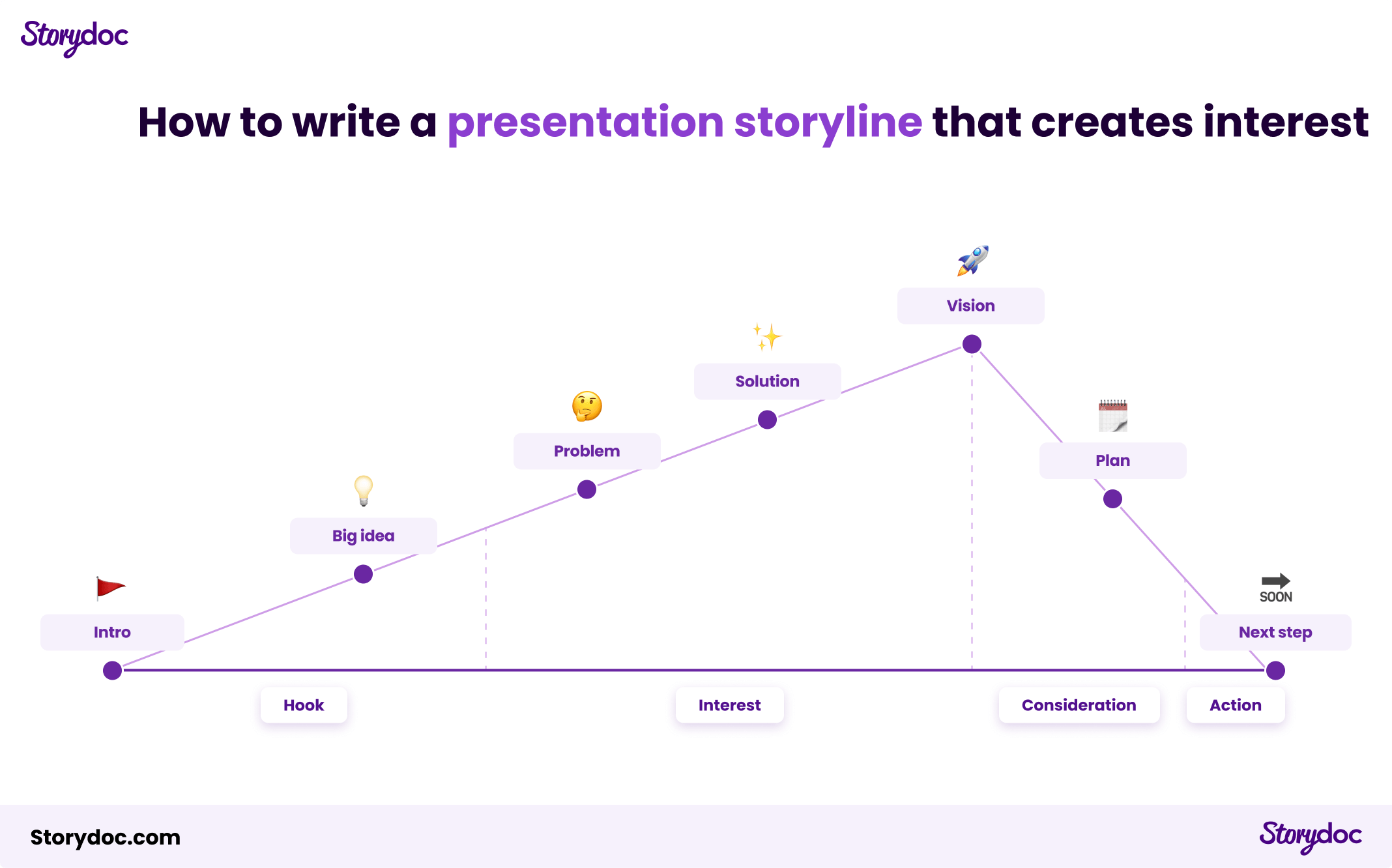
2. Concrete outcomes
Data provides the meat of your case study. Numbers, percentages, and concrete results serve as proof that your solution works.
It's one thing to claim that your product or service is effective, but showcasing the results achieved by a real customer through hard data adds credence to your assertions.
3. Visuals that support and expand on the text
Just as a picture is worth a thousand words, well-placed visuals in your case study can make the message clearer and more compelling.
Graphs, charts, and infographics can help break down complex data, making it easier for the audience to digest. Furthermore, they break up long blocks of text, making your case study more engaging.
4. Interactive elements
In a world where scrolling has become second nature, your case study needs to be more than a static document.
Incorporating interactive elements like tabs to click through benefits, live data calculators, or sliders with case studies and customer testimonials invites your audience to engage with your content actively.
Our research showed that decks with interactive elements got scrolled to the bottom 41% more often and had a 21% longer average reading time than non-interactive ones.
Making interactive case studies sounds complicated but it’s actually very easy if you do it with our AI case study creator . You can send it to prospects directly from Storydoc or embed it as part of your website.
By making your reader an active participant in the story, you boost their engagement and increase the chances of them reading your content through to the end.
Benefits of including interactive elements in your case study presentation
More decks read in full
Longer average reading time
5. Testimonials and quotes directly from customers
Customer testimonials and direct quotes inject a sense of authenticity and credibility into your case study.
They bring a human touch to your narrative and foster trust in potential clients.
It's no longer just your voice touting the effectiveness of your solution; it's the voice of a satisfied customer who has personally experienced the benefits of your product or service.
6. Clear call to action
Finally, after painting a vivid picture of your product or service in action, you need to tell your audience what to do next.
A clear CTA—whether it’s to learn more, book a demo, or sign up—makes the next step evident for your audience.
Our data reveals that decks with a clear next step had a conversion rate 27% higher than those that ended with a generic "thank you."
Make the next step simple, straightforward, and compelling, so your reader knows precisely what to do to start their own success story with you.
What not to include in your case study?
While we've covered the essentials to include in your case study, it's equally important to identify elements that could distract from your message, decrease trust, or even confuse your audience.
Here's what you should avoid including in your case study:
1. Unverified claims / data
Every claim you make and every piece of data you share in your case study must be true and easy to check.
Trust is crucial in a case study, and even one bit of wrong information can damage trust and hurt your image.
So, make sure all your facts, figures, and results are correct, and always get the right permissions to share them.
2. Confidential or sensitive information
When writing a case study, it's crucial to remember that privacy matters. Even though it's exciting to share all the details, you need to protect your client's private information.
Always get clear permission before using any client data and remember to hide any information that could identify specific individuals.
This careful approach shows your respect for privacy and builds trust with your audience, making your case study not just engaging, but also responsible and professional.
3. Technical jargon
A case study should be easy for everyone to understand, so avoid using industry-specific language. Even if you know the jargon, your audience might not.
Keeping your language simple and clear will help more people understand your case study. Too much technical language can confuse readers and distract from the story you're trying to tell.
4. Salesy language
While a case study is designed to show prospective clients how valuable your offer is, it's important not to sound too pushy.
A case study should tell a story, not sound like a sales pitch. Keep your language helpful and interesting. The success story should be enough to sell itself.
Create your best case study yet from ready-made templates
Now that you're equipped with all the essentials of crafting a compelling case study, it's time to bring your narrative to life.
Don’t work hard if you can work easy and get better results.
Interactive case study templates are your shortcut to creating engaging and informative case studies. They provide a clear path for your narrative, intuitive ways to present your data, and an engaging space for sharing customer testimonials.
Grab a template, and let your story do the talking!

Hi, I'm Dominika, Content Specialist at Storydoc. As a creative professional with experience in fashion, I'm here to show you how to amplify your brand message through the power of storytelling and eye-catching visuals.

Found this post useful?
Subscribe to our monthly newsletter.
Get notified as more awesome content goes live.
(No spam, no ads, opt-out whenever)
You've just joined an elite group of people that make the top performing 1% of sales and marketing collateral.
Create your best case study to date
Try Storydoc interactive case study creator for 14 days free (keep any presentation you make forever!)
How to Write a Case Study - All You Wanted to Know

What do you study in your college? If you are a psychology, sociology, or anthropology student, we bet you might be familiar with what a case study is. This research method is used to study a certain person, group, or situation. In this guide from our dissertation writing service , you will learn how to write a case study professionally, from researching to citing sources properly. Also, we will explore different types of case studies and show you examples — so that you won’t have any other questions left.
What Is a Case Study?
A case study is a subcategory of research design which investigates problems and offers solutions. Case studies can range from academic research studies to corporate promotional tools trying to sell an idea—their scope is quite vast.
What Is the Difference Between a Research Paper and a Case Study?
While research papers turn the reader’s attention to a certain problem, case studies go even further. Case study guidelines require students to pay attention to details, examining issues closely and in-depth using different research methods. For example, case studies may be used to examine court cases if you study Law, or a patient's health history if you study Medicine. Case studies are also used in Marketing, which are thorough, empirically supported analysis of a good or service's performance. Well-designed case studies can be valuable for prospective customers as they can identify and solve the potential customers pain point.
Case studies involve a lot of storytelling – they usually examine particular cases for a person or a group of people. This method of research is very helpful, as it is very practical and can give a lot of hands-on information. Most commonly, the length of the case study is about 500-900 words, which is much less than the length of an average research paper.
The structure of a case study is very similar to storytelling. It has a protagonist or main character, which in your case is actually a problem you are trying to solve. You can use the system of 3 Acts to make it a compelling story. It should have an introduction, rising action, a climax where transformation occurs, falling action, and a solution.
Here is a rough formula for you to use in your case study:
Problem (Act I): > Solution (Act II) > Result (Act III) > Conclusion.
Types of Case Studies
The purpose of a case study is to provide detailed reports on an event, an institution, a place, future customers, or pretty much anything. There are a few common types of case study, but the type depends on the topic. The following are the most common domains where case studies are needed:

- Historical case studies are great to learn from. Historical events have a multitude of source info offering different perspectives. There are always modern parallels where these perspectives can be applied, compared, and thoroughly analyzed.
- Problem-oriented case studies are usually used for solving problems. These are often assigned as theoretical situations where you need to immerse yourself in the situation to examine it. Imagine you’re working for a startup and you’ve just noticed a significant flaw in your product’s design. Before taking it to the senior manager, you want to do a comprehensive study on the issue and provide solutions. On a greater scale, problem-oriented case studies are a vital part of relevant socio-economic discussions.
- Cumulative case studies collect information and offer comparisons. In business, case studies are often used to tell people about the value of a product.
- Critical case studies explore the causes and effects of a certain case.
- Illustrative case studies describe certain events, investigating outcomes and lessons learned.
Need a compelling case study? EssayPro has got you covered. Our experts are ready to provide you with detailed, insightful case studies that capture the essence of real-world scenarios. Elevate your academic work with our professional assistance.

Case Study Format
The case study format is typically made up of eight parts:
- Executive Summary. Explain what you will examine in the case study. Write an overview of the field you’re researching. Make a thesis statement and sum up the results of your observation in a maximum of 2 sentences.
- Background. Provide background information and the most relevant facts. Isolate the issues.
- Case Evaluation. Isolate the sections of the study you want to focus on. In it, explain why something is working or is not working.
- Proposed Solutions. Offer realistic ways to solve what isn’t working or how to improve its current condition. Explain why these solutions work by offering testable evidence.
- Conclusion. Summarize the main points from the case evaluations and proposed solutions. 6. Recommendations. Talk about the strategy that you should choose. Explain why this choice is the most appropriate.
- Implementation. Explain how to put the specific strategies into action.
- References. Provide all the citations.

How to Write a Case Study
Let's discover how to write a case study.

Setting Up the Research
When writing a case study, remember that research should always come first. Reading many different sources and analyzing other points of view will help you come up with more creative solutions. You can also conduct an actual interview to thoroughly investigate the customer story that you'll need for your case study. Including all of the necessary research, writing a case study may take some time. The research process involves doing the following:
- Define your objective. Explain the reason why you’re presenting your subject. Figure out where you will feature your case study; whether it is written, on video, shown as an infographic, streamed as a podcast, etc.
- Determine who will be the right candidate for your case study. Get permission, quotes, and other features that will make your case study effective. Get in touch with your candidate to see if they approve of being part of your work. Study that candidate’s situation and note down what caused it.
- Identify which various consequences could result from the situation. Follow these guidelines on how to start a case study: surf the net to find some general information you might find useful.
- Make a list of credible sources and examine them. Seek out important facts and highlight problems. Always write down your ideas and make sure to brainstorm.
- Focus on several key issues – why they exist, and how they impact your research subject. Think of several unique solutions. Draw from class discussions, readings, and personal experience. When writing a case study, focus on the best solution and explore it in depth. After having all your research in place, writing a case study will be easy. You may first want to check the rubric and criteria of your assignment for the correct case study structure.
Read Also: ' WHAT IS A CREDIBLE SOURCES ?'
Although your instructor might be looking at slightly different criteria, every case study rubric essentially has the same standards. Your professor will want you to exhibit 8 different outcomes:
- Correctly identify the concepts, theories, and practices in the discipline.
- Identify the relevant theories and principles associated with the particular study.
- Evaluate legal and ethical principles and apply them to your decision-making.
- Recognize the global importance and contribution of your case.
- Construct a coherent summary and explanation of the study.
- Demonstrate analytical and critical-thinking skills.
- Explain the interrelationships between the environment and nature.
- Integrate theory and practice of the discipline within the analysis.

Wednesday Addams
Mysterious, dark, and sarcastic
You’re the master of dark humor and love standing out with your unconventional style. Your perfect costume? A modern twist on Wednesday Addams’ gothic look. You’ll own Halloween with your unapologetically eerie vibe. 🖤🕸️
Need Case Study DONE FAST?
Pick a topic, tell us your requirements and get your paper on time.
Case Study Outline
Let's look at the structure of an outline based on the issue of the alcoholic addiction of 30 people.
Introduction
- Statement of the issue: Alcoholism is a disease rather than a weakness of character.
- Presentation of the problem: Alcoholism is affecting more than 14 million people in the USA, which makes it the third most common mental illness there.
- Explanation of the terms: In the past, alcoholism was commonly referred to as alcohol dependence or alcohol addiction. Alcoholism is now the more severe stage of this addiction in the disorder spectrum.
- Hypotheses: Drinking in excess can lead to the use of other drugs.
- Importance of your story: How the information you present can help people with their addictions.
- Background of the story: Include an explanation of why you chose this topic.
- Presentation of analysis and data: Describe the criteria for choosing 30 candidates, the structure of the interview, and the outcomes.
- Strong argument 1: ex. X% of candidates dealing with anxiety and depression...
- Strong argument 2: ex. X amount of people started drinking by their mid-teens.
- Strong argument 3: ex. X% of respondents’ parents had issues with alcohol.
- Concluding statement: I have researched if alcoholism is a disease and found out that…
- Recommendations: Ways and actions for preventing alcohol use.
Writing a Case Study Draft
After you’ve done your case study research and written the outline, it’s time to focus on the draft. In a draft, you have to develop and write your case study by using: the data which you collected throughout the research, interviews, and the analysis processes that were undertaken. Follow these rules for the draft:

Use Data to Illustrate Key Points in Your Case Study
Even though your case study is a story, it should be based on evidence. Use as much data as possible to illustrate your point. Without the right data, your case study may appear weak and the readers may not be able to relate to your issue as much as they should. Let's see the examples from essay writing service :
With data: Alcoholism is affecting more than 14 million people in the USA, which makes it the third most common mental illness there. Without data: A lot of people suffer from alcoholism in the United States.
Try to include as many credible sources as possible. You may have terms or sources that could be hard for other cultures to understand. If this is the case, you should include them in the appendix or Notes for the Instructor or Professor.
Finalizing the Draft: Checklist
After you finish drafting your case study, polish it up by answering these ‘ask yourself’ questions and think about how to end your case study:
- Check that you follow the correct case study format, also in regards to text formatting.
- Check that your work is consistent with its referencing and citation style.
- Micro-editing — check for grammar and spelling issues.
- Macro-editing — does ‘the big picture’ come across to the reader? Is there enough raw data, such as real-life examples or personal experiences? Have you made your data collection process completely transparent? Does your analysis provide a clear conclusion, allowing for further research and practice?
Problems to avoid:
- Overgeneralization – Do not go into further research that deviates from the main problem.
- Failure to Document Limitations – Just as you have to clearly state the limitations of a general research study, you must describe the specific limitations inherent in the subject of analysis.
- Failure to Extrapolate All Possible Implications – Just as you don't want to over-generalize from your case study findings, you also have to be thorough in the consideration of all possible outcomes or recommendations derived from your findings.
How to Create a Title Page and Cite a Case Study
Let's see how to create an awesome title page.
Your title page depends on the prescribed citation format. The title page should include:
- A title that attracts some attention and describes your study
- The title should have the words “case study” in it
- The title should range between 5-9 words in length
- Your name and contact information
- Your finished paper should be only 500 to 1,500 words in length.With this type of assignment, write effectively and avoid fluff
Here is a template for the APA and MLA format title page:
There are some cases when you need to cite someone else's study in your own one – therefore, you need to master how to cite a case study. A case study is like a research paper when it comes to citations. You can cite it like you cite a book, depending on what style you need.
Citation Example in MLA Hill, Linda, Tarun Khanna, and Emily A. Stecker. HCL Technologies. Boston: Harvard Business Publishing, 2008. Print.
Citation Example in APA Hill, L., Khanna, T., & Stecker, E. A. (2008). HCL Technologies. Boston: Harvard Business Publishing.
Citation Example in Chicago Hill, Linda, Tarun Khanna, and Emily A. Stecker. HCL Technologies.
Case Study Examples
To give you an idea of a professional case study example, we gathered and linked some below.
Eastman Kodak Case Study
Case Study Example: Audi Trains Mexican Autoworkers in Germany
To conclude, a case study is one of the best methods of getting an overview of what happened to a person, a group, or a situation in practice. It allows you to have an in-depth glance at the real-life problems that businesses, healthcare industry, criminal justice, etc. may face. This insight helps us look at such situations in a different light. This is because we see scenarios that we otherwise would not, without necessarily being there. If you need custom essays , try our research paper writing services .
Get Help Form Qualified Writers
Crafting a case study is not easy. You might want to write one of high quality, but you don’t have the time or expertise. If you’re having trouble with your case study, help with essay request - we'll help. EssayPro writers have read and written countless case studies and are experts in endless disciplines. Request essay writing, editing, or proofreading assistance from our custom case study writing service , and all of your worries will be gone.
Don't Know Where to Start?
Crafting a case study is not easy. You might want to write one of high quality, but you don’t have the time or expertise. Request ' write my case study ' assistance from our service.
What Is A Case Study?
How to cite a case study in apa, how to write a case study.

Daniel Parker
is a seasoned educational writer focusing on scholarship guidance, research papers, and various forms of academic essays including reflective and narrative essays. His expertise also extends to detailed case studies. A scholar with a background in English Literature and Education, Daniel’s work on EssayPro blog aims to support students in achieving academic excellence and securing scholarships. His hobbies include reading classic literature and participating in academic forums.

is an expert in nursing and healthcare, with a strong background in history, law, and literature. Holding advanced degrees in nursing and public health, his analytical approach and comprehensive knowledge help students navigate complex topics. On EssayPro blog, Adam provides insightful articles on everything from historical analysis to the intricacies of healthcare policies. In his downtime, he enjoys historical documentaries and volunteering at local clinics.


- Introduction
- About Case Study Reports
Section A: Overview
- Section B: Planning and Researching
- Section C: Parts of a Case Study
- Section D: Reviewing and Presenting
- Section E: Revising Your Work
- Section F: Resources
- Your Workspace
- Guided Writing Tools
- About Lab Reports
- Section C: Critical Features
- Section D: Parts of a Lab Report
- About Literature Review
- Section C: Parts of a Literature Review
- Section D: Critical Writing Skills
- About Reflective Writing
- Section B: How Can I Reflect?
- Section C: How Do I Get Started?
- Section D: Writing a Reflection
Case Study Report Prepared by University of Guelph
This section will provide you with an overview of case study reports and what components you should include when writing them.
What Will I Learn?
By successfully completing this section, you should be able to:
- describe what a case study report is and how it is used,
- identify the components of a case study and how they fit together, and
- explain why case studies are popular in business education.

Prepared by

In general, a case study is a historical or fictional description of a business situation. Case studies are stories that contain a particular management problem or decision that needs to be made. They are usually very detailed and contain information about key stakeholders, organizational processes, products, markets, financials, and so on.
The case study method of teaching plays an important role in management education (e.g., Banning, 2003) and is commonly used in management education programs (e.g., Conger & Xin, 2000). Case studies present vivid and engaging examples of realistic business situations that allow students to apply theoretical concepts (Barkley, Cross, & Major, 2005).
A Case Study Is:
a partial, historical, clinical study of a situation which has confronted a practising administrator or managerial group. Presented in a narrative form to encourage student involvement, it provides data—substantive and process—essential to analysis of a specific situation, for the framing of alternative action programs, and for their implementation, recognising the complexity and ambiguity of the practical world.
(Barnes, Christensen, and Hansen, 1994, p. 44)
As Barnes et al. (1994) explain in the definition above, an engaging case study will provide a managerial dilemma that models the complexity of real world business decisions. Moreover, these decisions need to be made considering the analysis of data, assessment of viable alternatives, proposed recommendations, and associated implementation plan.
Components of A Case Study Report
What should a case study report include.
The components of a case study report will vary depending on the preferences of your institution and instructor. Be sure to refer to your assignment instructions to find out what will be required in your context.
Most case study reports will include the following major sections and components:
- Cover page including basic student and class information
- Table of contents showing where key parts of the report can be found
- Executive summary of the key recommendations and points of the report
- Introduction to the report and identification of the focal problem being faced
- Analysis of the problem and application of course/program content
- Decision criteria and possible alternatives for solving the problem
- Recommendation for solving the problem
- Implementation plan for executing the recommendation and ensuring its success
- Exhibits that help to elaborate upon the content included in the report
- Reference list of any sources that were used at any point in the case study project
There are many possible subsections within these components. The following information provides a more detailed explanation of each component as well as specific strategies to help with writing.
Case Study Report Template
What are the components of a case study presentation.
The components of a case study presentation will likely also vary depending on the preferences of your institution and instructor; however, most case study presentations will likely include an oral as well as a visual (e.g., PowerPoint) summary of the 10 major sections and components. The case study report template provided will give you with a method for presenting your case study project as well as specific strategies to help with presenting the various sections.
Case Study Report Outline Template
This outline sample of a Case Study Report should serve as a useful guide to help you get started.
Download PDF
Download the Case Study Report Outline Template .
Preview: PDF Worksheet

Business Courses and Case Studies
Why do business courses use case studies.
This short video introduces business case study reports by highlighting why case studies are popular in business education and what you can expect as a learner completing a case study report.

Business Case Studies
Video : Four awesome things about business case studies.
Business Case Studies | MP4 Video (01:03)
Four awesome things about business case studies. Number one; case studies give you a chance to examine business problems you might actually encounter in real life. Cases are based on real situations or realistic scenarios simulating complex and ambiguous problems from the business world. Number two; case studies can help you strengthen your critical thinking and problem-solving skills. You'll get practice analyzing stakeholders, organizational processes, and financial constraints. And you'll learn how to make decisions and solve problems in a safe and transparent environment. Number three; case studies are not lectures [snoring]. Enough said. Number four; case study assignments combine writing, research and oral presentation sells. All stuff you want to get better, right?
Self Assessment
- Which of the following was part of the definition of a case study as presented in this section?
- Which of the following was not one of the major sections and components mentioned in this section?
- Case studies were first developed as:
- The components of a case study report will likely be exactly the same across institutions and instructors.
Key Takeaways and References
Key takeaways & references, key takeaways.
- Case studies are rich, vivid situational exercises that can be used to make decisions and solve problems in a safe and transparent environment.
- Most case study reports follow an established pattern of core components with some variations depending on the context of the report.
- Case study reports allow business students an opportunity to hone their critical thinking skills for the complex and ambiguous situations that they are likely to encounter at work.
Banning, K. (2003). The effect of the case method on tolerance for ambiguity . Journal of Management Education, 27, 556–568.
Barkley, E. F, Cross, K. P. & Major, C. H. (2005). Collaborative learning techniques: A handbook for college faculty . San-Francisco: Jossey-Bass.
Barnes, L. B., Christensen, C. R., & Hansen, A. B. (1994). Teaching and the case method (3rd ed.). Cambridge, MA: Harvard Business School Press.
Conger, J. A., & Xin, K. (2000). Executive education in the 21st century . Journal of Management Education, 24, 73–101.
Redpath, L. (2012). Confronting the bias against on-line learning in management education . Academy of Management Learning & Education, 11, 125–140.
University of Guelph. (2015). Four awesome things about business case studies [WriteOnline_GUELPHIntro.mp4]. Published with GoAnimate: http://goanimate.com.
University of Guelph. (2015). Case Study Report Outline Template . (PDF).
Young, S. (2006). Student views of effective online teaching in higher education . The American Journal of Distance Education, 20, 65–77.
Next Section Overview
In Section B: Planning and Researching, we will explore how to analyze your case study report assignment and create a writing plan.

What is a Case Study: A Complete Guide of Case Study Basics

What is a case study? A case study is an in-depth analysis of a real-life situation or project in business. Case studies are not just theoretical exercises; they are practical tools that can empower marketers and entrepreneurs. They showcase successes, offer insights into practical strategies, and help attract and convert potential clients.
What is a Case Study
- Definition: In-depth analysis of a real-life business situation or project, providing insights and showcasing successes.
- Purpose of a Case Study: Demonstrate effective strategies and attract potential clients by highlighting real-world applications and results.
- Components: Background, executive summary, challenges, solutions, conclusion, and call-to-action.
Let’s delve into the transformative potential of case studies in different business contexts. With the right case study templates, we can decode the perplexing concept of case studies and understand their importance, from their definition to their advantages. This understanding can inspire new strategies and approaches in your business.
Table of Contents
Specific case studies for different industries, why are case studies important.
- Benefits and Limitations of Case Studies
Case Study vs Use Case
Case study vs. white paper.
- Case Study vs Survey
Case Study vs. Research Study
- Case Study vs Report
What Does a Case Study Look Like
What is a case study method, is case study qualitative or quantitative, types of case studies.
Let’s explore how to define a case study and what it means for business success.
A case study is more than just a report; it’s a window into real-world business challenges and triumphs. As per the case study definition, it’s like a roadmap, guiding marketing associates, small business owners, and company leaders through identifying challenges and showing strategic solutions for success.
Through information gathering, client interviews, and deep analysis, case studies shed light on the past hurdles and the strategies that conquered them. These are not just for showcasing achievements; these are invaluable tools for training new team members and impressing potential clients. But to make them truly impactful, they need structure and finesse.
Here’s a staggering fact that underscores the importance of case studies. About 29% of prospects rely on case studies to make informed purchasing decisions. This highlights the significant role case studies play in shaping business outcomes.
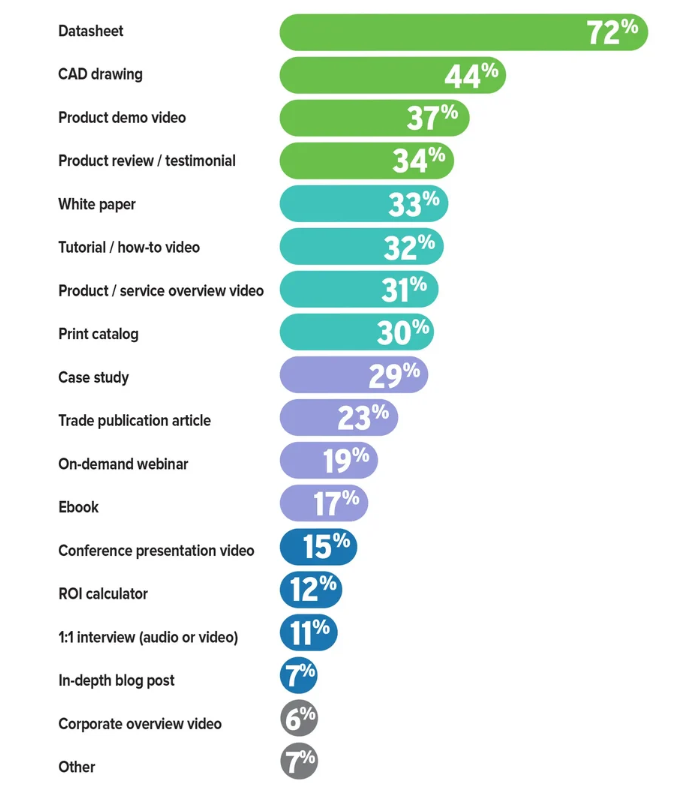
We understand your business goals and solutions are particular, and you need a case study design that suits your purpose. Let’s explore different case studies and how to align them with your business.
What is a Case Study in Accounting
A brilliant case study in accounting illuminates the practical application of accounting principles in a real-world scenario. It should be informative and engaging, demonstrating the impact of sound accounting practices.
If you need to create an accounting case study, always focus on clean, clutter-free design formats that leave enough room to discuss real-life scenarios, like the following case study template.

Get This Template and More
Curious about what to include in a case study for accounting firms?
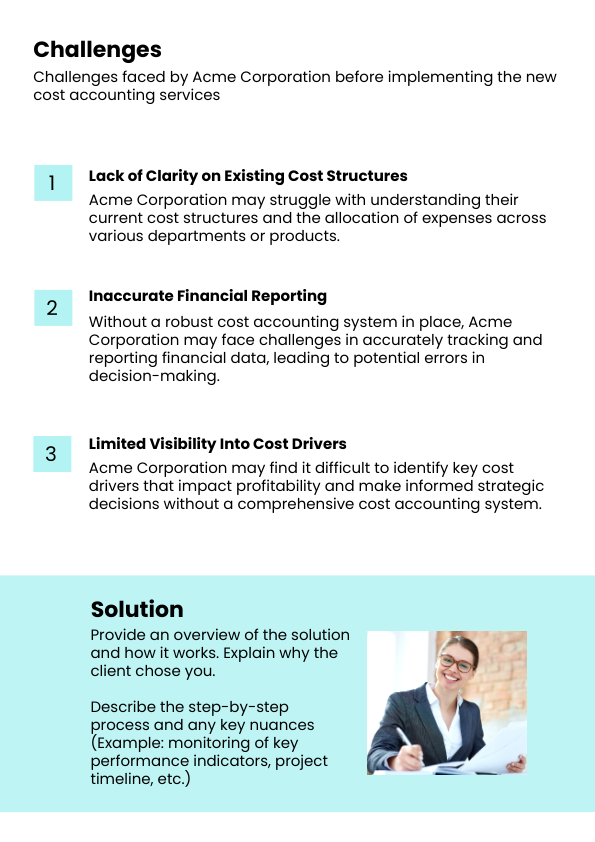
As shown in the example of the case study in accounting, there are relatable accounting issues, such as improving profitability, optimizing cash flow, or navigating a new tax regulation. Stay ahead by showcasing the specific accounting methods or strategies to address the client’s challenge. You can demonstrate your expertise by highlighting implemented accounting principles to achieve a positive outcome in your case study.
What are Management Consulting Case Studies
A consulting case study puts you in the shoes of a consultant tasked with analyzing the situation and recommending solutions. It’s a chance to showcase your problem-solving skills and strategic thinking under pressure.
Here’s a consulting case study example template.

Use a structured approach to describe the issue, showcasing your adeptness in critical thinking and solution prioritization in the case study for consulting. Additionally, utilize case study templates of various consulting disciplines such as management, strategy, and leadership consulting. These templates display your proficiency in breaking down the problem systematically, addressing a tangible challenge encountered by a particular company or industry.
Here’s an example of an HR consulting case study that’s easily customizable.
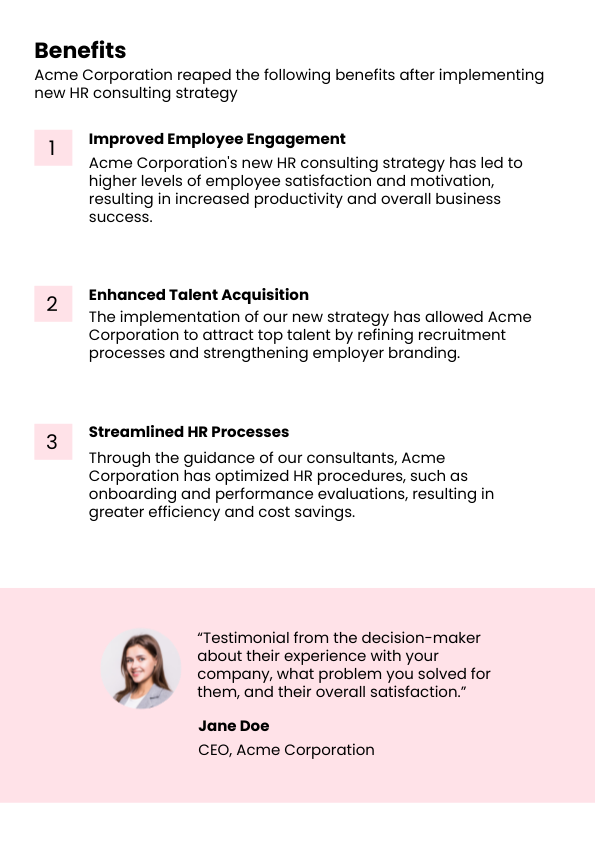
What is a Design Case Study
Think of a design case study as a visual narrative. It tells the story of a design project, from the initial challenge to the final, successful solution. Moreover, it showcases your design process, decision-making, and work’s impact on the client’s goals.
Therefore, your design case study should align with the services you can offer for your client’s problem. DocHipo provides case studies on UI design, motion design, illustration design, brand identity and advertising design, and many other design-related templates.
Check out the web design case study template that starts with a clear and relatable design problem.

After showcasing relevant user research data and insights to demonstrate a data-driven solution, you must add a strong call to action and brief information about your company to convert your leads into customers.
What is a Case Study for IT Company
Case studies for IT companies are success stories that showcase expertise in solving B2B real-world problems through technology. They are a way to demonstrate your capabilities, build trust with potential clients, and position yourself as a trusted advisor.
But what makes a great IT case study?
Use relevant data and metrics to depict the client’s initial situation. This could include IT costs, system downtime, or user productivity levels. You can create case studies for mobile app development, web development, and cyber security services to set your company apart in IT and management solutions.
Let’s explore the example of a case study for project management tailored to the needs of project managers and marketing executives.

This customizable template allows you to display the IT solutions you implemented and explain how you addressed the client’s needs.
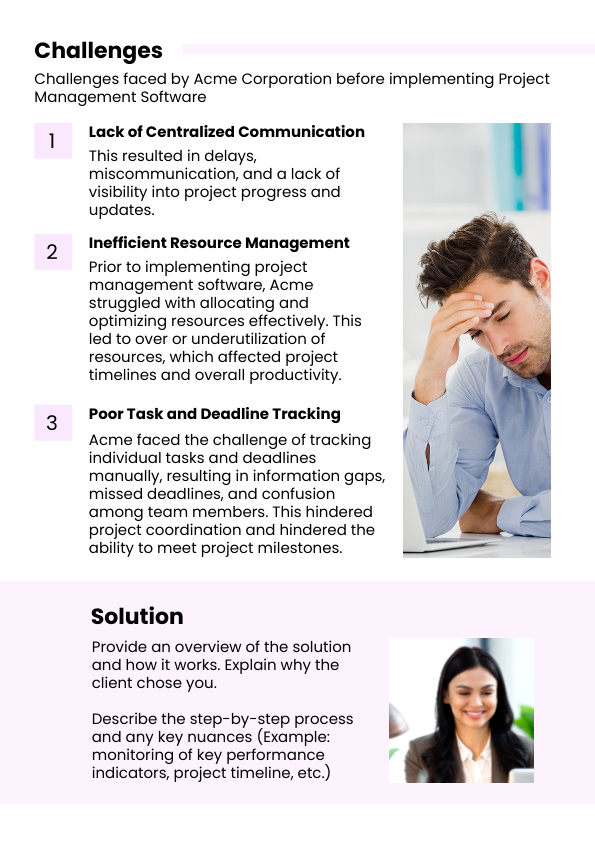
What is a Case Study in Marketing
Curious about marketing case studies? These powerful tools reveal how your offerings drive success for clients. Whether external client victories or internal wins, a marketing case study paints a vivid picture of achievement.
From company backstory to concrete results, it covers all bases: background, challenges, solutions, actions, and outcomes. Plus, it’s not just about words—incorporating visuals and client testimonials boosts credibility.
Check out the marketing case study example templates that pave the path to success in your business endeavors.
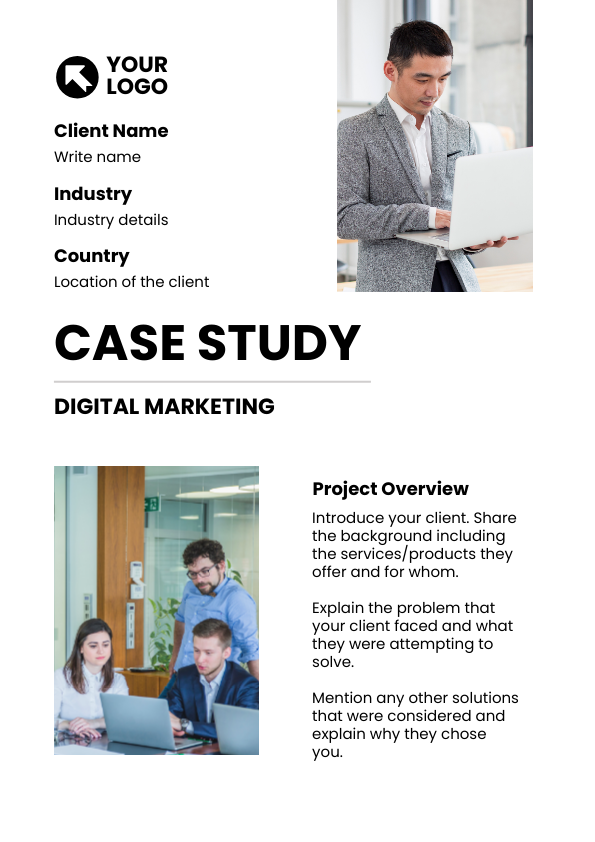
This marketing case study template immediately grabs your attention with its clean and modern design, ensuring every detail is easy to follow and understand.
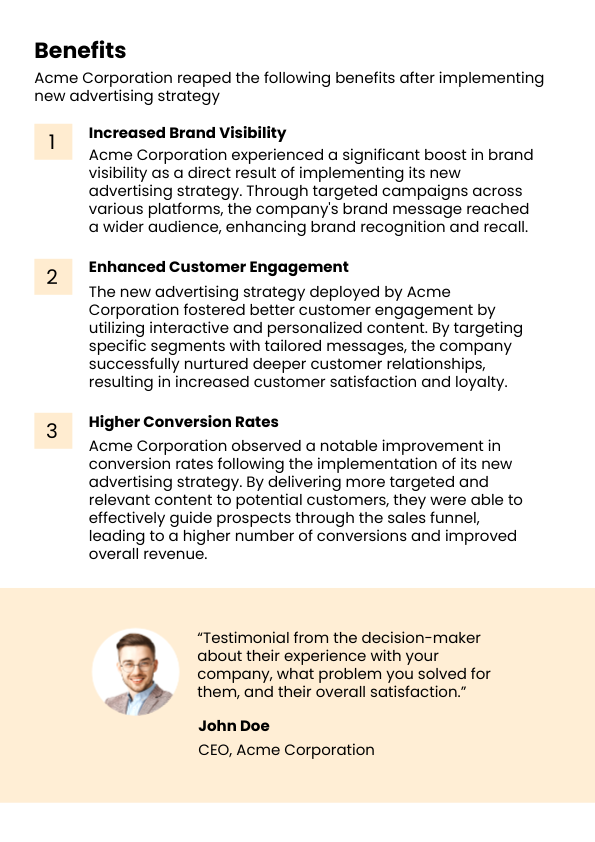
Writing a compelling marketing case study starts with the customer. The above advertising case study template tells the story of a real client facing a relatable challenge. As we said before, a marketing case study is your sweet spot for engaging your leads who want to overcome the same challenging situations. Let it lead the way for your inventive solutions, ensuring credibility and a top spot in the B2B market.
Turn heads and win hearts with DocHipo’s marketing case study templates . From digital marketing to mobile marketing, search engine optimization, email marketing, and beyond, these templates help you tell your success stories in a way that connects with real people.
What are Case Studies in Sofware
Imagine a compelling story that brings your software to life. A software case study delves into a real-world scenario where your software tackled a specific challenge for a client. It demonstrates your software’s problem-solving capabilities and the positive outcomes it delivered.
DocHipo software case studies are useful for niche-based services, from HR to AI assistant software.
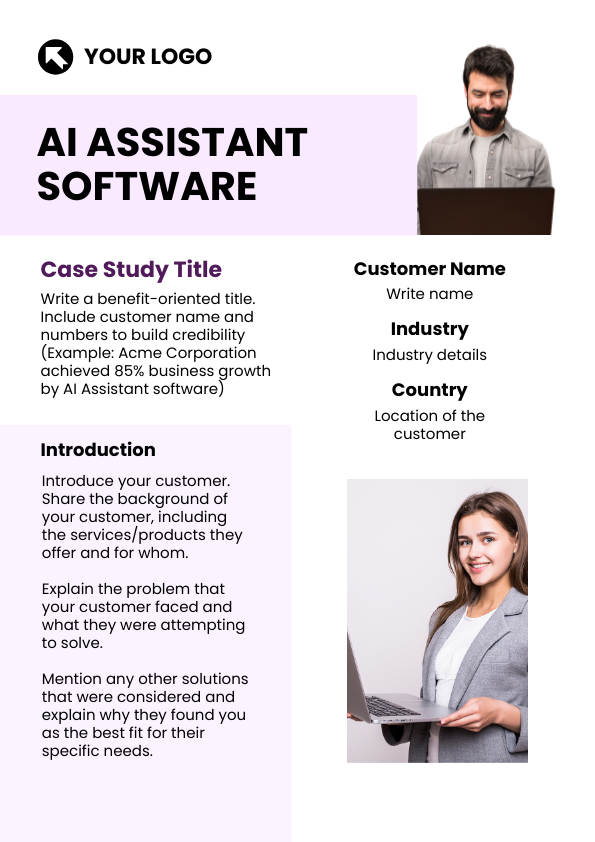
Introduce the client’s struggles and showcase how your software provided the solution. Demonstrate the positive impact your software had on the client’s business goals. This could be increased efficiency, cost savings, or improved user engagement.
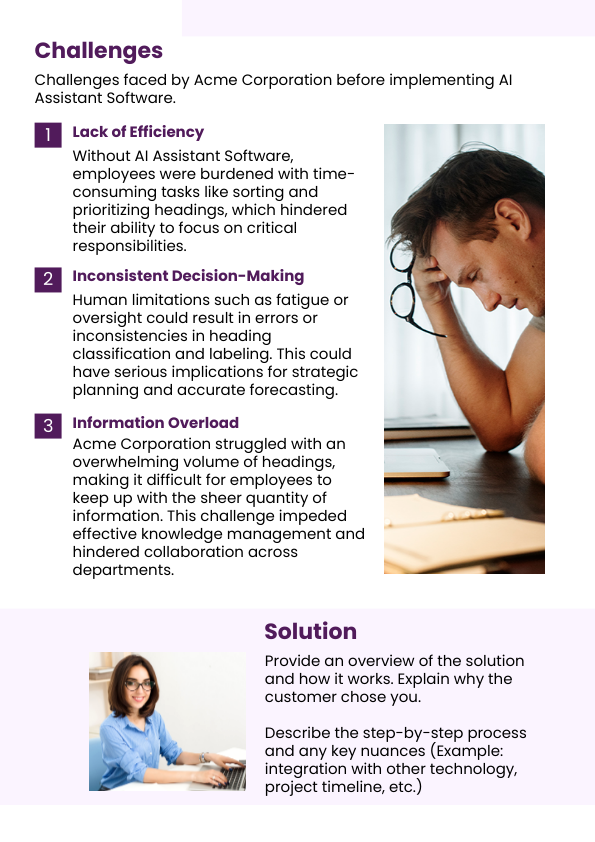
What are Case Studies in Business
A business case study is like a detailed story about a company. It shows how they solved a problem, succeeded, or faced challenges. Companies use these stories to share how well their ideas and strategies worked.
Here is a business case study example from Trello .
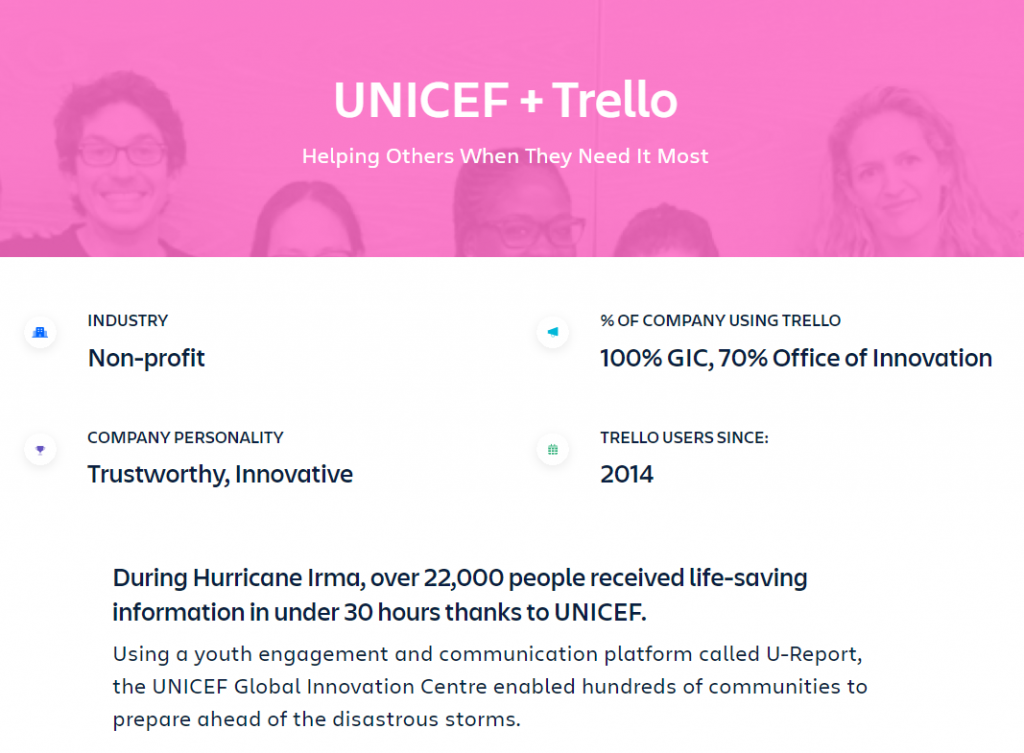
What is the purpose of a case study? Case studies thoroughly evaluate specific situations. They reveal which strategies worked, which didn’t, and what could be improved. This insight is invaluable for future planning.
Furthermore, case studies help identify potential solutions to problems. Examining similar past situations allows you to discover effective strategies and avoid common pitfalls.
Finally, use case studies to target your audience and showcase your expertise. Publishing successful case studies demonstrates your ability to solve problems, boost your credibility, and attract more business. Essentially, case studies serve as the original form of social proof, highlighting your problem-solving skills and success stories.
Benefits and Limitations of Case Studies
Before creating this SEO-centric lead magnet, you should consider the advantages and disadvantages of case studies.
We’ve listed the difference between a use case and a case study.
Often, marketers get misled by the similarities between a case study and a white paper. Though both are time-consuming and heavily research-oriented, everything about the two types of content is distinguishable, from the content format to the goals.
Case Study vs Survey
Though case studies and surveys can both use quantitative and qualitative methods, often known as mixed methodology, some distinguishable factors draw a prominent line between the two types of marketing and research content.
The research study aims to address a specific issue promptly. In contrast, case studies are conducted over a longer period. They focus on observing and analyzing an ongoing phenomenon. Here are the key differences that will help you better understand the format and purpose of a case study and research paper.
Case Study vs Report
Even though case studies and case reports have been used interchangeably, the format of a case study is distinctively different from that of a case report.
A basic, insightful case study has six aspects to focus on in its design; take a look at the case study template.
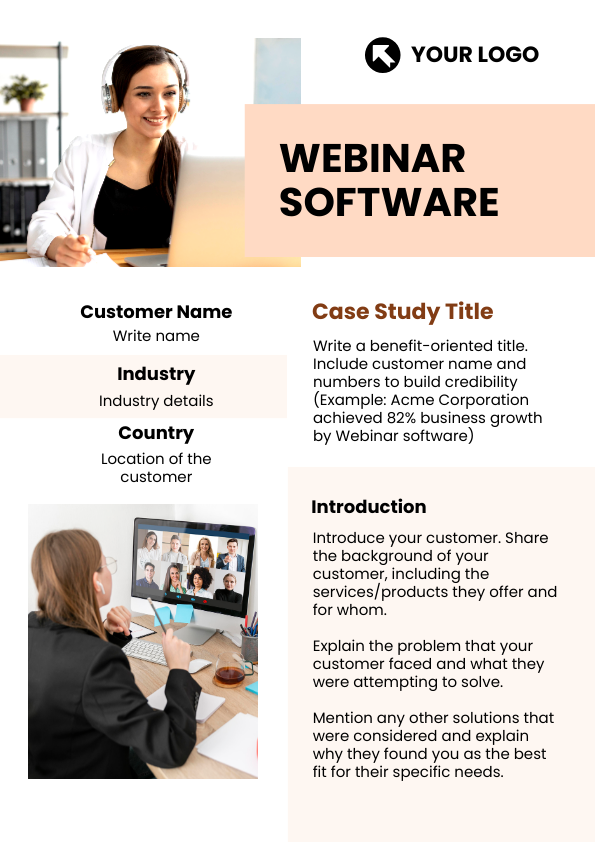
- Background: Provide essential context about the client or situation.
- Executive Summary: Capture attention with a brief introduction to the subject, the company’s products, services, challenges, and the reason for partnering with you.
- Challenges: Analyze and explain the specifics of the challenges faced by the client.
- Proposed Solutions: Present and justify the recommended solutions clearly.
- Conclusion: Summarize key takeaways, highlighting the client’s success with data and quotes.
- Call-to-Action: Include contact channels and a strong CTA like “Call Us” or “Visit Us.”
The methods used in case study writing are varied and adaptable, tailored to the specific needs of each case. Here are some common case study methods:
1. Interviews
Interviews involve engaging with individuals directly related to the case to gather first-hand information and insights.
Key points:
- One-on-one or group settings
- In-depth and personal perspectives
- Allows follow-up questions for clarity
When is this method useful:
Ideal for cases requiring detailed personal experiences, such as understanding customer satisfaction or employee feedback.
2. Observation
Observation entails directly watching the subject or situation to collect data on behaviors and interactions.
- Real-time data collection
- Provides contextual details
- Minimally intrusive if done discretely
Best for studies needing direct insights into processes, like workflow efficiency or consumer behavior.
3. Document Analysis
Document analysis examines existing documents and records relevant to the case.
Key Points:
- Uses existing written materials
- Provides historical context
- Can validate other data sources
Suitable for cases involving historical research or policy analysis.
4. Surveys and Questionnaires
Surveys and questionnaires are used to collect quantitative data from relevant stakeholders.
- Structured and standardized method
- Efficient for large sample sizes
- Quantifiable data for statistical analysis
Ideal for cases needing broad quantitative insights, like market research or employee satisfaction studies.
5. Participant Observation
Participant observation combines direct observation with active involvement in the activities related to the case.
- Insider’s perspective
- Rich, detailed data
- Balances observation with participation
Useful for ethnographic studies or understanding cultural practices within an organization.
6. Triangulation
Triangulation involves using multiple methods to cross-verify and validate findings.
- Enhances reliability
- Cross-verifies data
- Integrates diverse perspectives
Ideal for comprehensive studies requiring robust validation, like multi-faceted business issues.
7. Ethnography
Ethnography immerses the researcher in the subject’s environment over an extended period to understand cultural contexts.
- Long-term immersion
- Focus on social dynamics
- In-depth cultural insights
Best for understanding complex social interactions and cultural phenomena.
A case study can actually be both. Ideally, it should blend objective measurements with subjective insights to give a full picture of what’s happening and why. The right mix of qualitative and quantitative data depends on the specific field and situation, but both types are incredibly valuable.
Think of it this way: qualitative data adds depth and context, while quantitative data provides hard facts and figures. Together, they offer a more detailed and nuanced understanding, moving beyond simple averages and generalizations.
There are six types of case study formats: Descriptive, Explanatory, Exploratory, Collective, Intrinsic, and Instrumental.
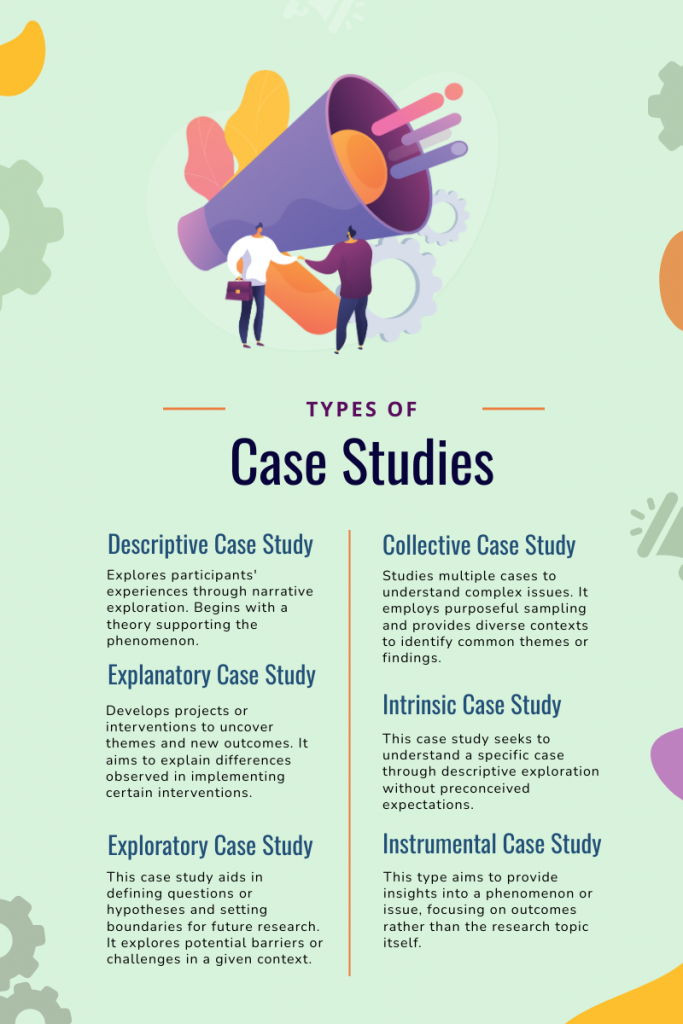
Knowing “What is a case study” should be the first step in creating a case study. Sometimes, marketers get stuck on how to make a case study easily. Try DocHipo case study templates with customizable designs in accounting, consulting, design, technical or IT services, marketing, and software. Sign up for free and save time with suitable pre-designed industry-specific challenges and benefits that align with your business solutions.
What are the limitations of a case study?
There are two main disadvantages: limited generalizability and applicability to broader contexts and the potential for researcher bias due to subjective data interpretation.
When should you do a case study?
A case study is ideal when you want to gain in-depth insights into a specific real-life situation or phenomenon. Also, you can use case studies to create a strong authority for your brand presence.
What is the difference between a case study and an essay?
A case study focuses on a specific real-life situation or problem and its solutions, while an essay is more general and can cover a wide range of topics. Also, the format and length of these two content are very different.
What is the difference between a case study and action research?
A case study is an in-depth analysis of a specific instance, while action research focuses on making specific changes to address a problem and involves reflection and inquiry.
How do you describe a case study?
A case study focuses on a real-life situation or problem. It provides a detailed analysis of the issue and discusses the solutions and their outcomes.
What are the most important parts of a case study?
A case study has six important parts: background, executive summary, challenges, solutions, conclusion, and CTA for conversion.

Turn your ideas into beautiful design
No prior design skill required

Talk to Sales
Wherever you are on your Dochipo journey, you can always get in touch.

Talk to Support

IMAGES
COMMENTS
Feb 1, 2022 · In this blog, I’ll explain what case studies are and share the eight essential components of a case study. What is a Case Study? From a broad perspective, a case study is an in-depth analysis of a particular subject. Generally, the study covers a problem-solution-results format.
4 days ago · A well-structured case study contains several components that work together to tell a cohesive story. Let’s break down them: Title: The title should be catchy and informative, giving a clear idea of what the case study is about. Executive Summary: This is a brief overview that summarizes the case study’s content, objectives, and results ...
The sections that are included in the case study are executive summary, introduction, analysis, alternatives and decision criteria, recommendations and implementation plan, conclusions and references, citing sources. Before moving towards a detailed view of the case study format, let us have a look at the case study benefits. Value of Case Study.
In this post, discover the 10 key components of a case study that you need to include. This post is part of a series on how to write a B2B case study. 1. Develop a results-oriented title. Your case study title needs to resonate. Do this by providing results-oriented information your audience cares about.
Crafting your case study is like writing a gripping novel, filled with characters, conflicts, and resolutions. Each component of your case study serves a unique purpose in narrating the story of how your product or service helps your clients conquer their challenges. Here are the main chapters of your case study structure: 1. Introduction
Feb 15, 2023 · Learn how to write a case study from doing research to citing sources properly. We explore the different types of case studies and provide writing help.
The most defining characteristics of case study is delimiting the object of the study: the case (Merriam, 2015) • The goal is to understand one thing well: a person, a program,
Case studies are rich, vivid situational exercises that can be used to make decisions and solve problems in a safe and transparent environment. Most case study reports follow an established pattern of core components with some variations depending on the context of the report.
Nov 14, 2024 · Purpose of a Case Study: Demonstrate effective strategies and attract potential clients by highlighting real-world applications and results. Components: Background, executive summary, challenges, solutions, conclusion, and call-to-action.
Aug 17, 2024 · Effective case studies separate scenarios into parts. This allows you to analyse every aspect of the scenario. Here are the basic parts of a case study: Title: This section identifies or presents the scenario in one line or sentence. Overview: This offers a summary, discussing the scenario in detail.